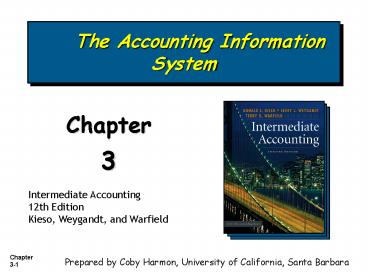The Accounting Information System - PowerPoint PPT Presentation
1 / 19
Title:
The Accounting Information System
Description:
Title: Financial Accounting and Accounting Standards Author: Coby Harmon Last modified by: USER Created Date: 3/28/1997 6:03:02 PM Document presentation format – PowerPoint PPT presentation
Number of Views:258
Avg rating:3.0/5.0
Title: The Accounting Information System
1
The Accounting Information System
- Chapter
- 3
Intermediate Accounting 12th Edition Kieso,
Weygandt, and Warfield
Prepared by Coby Harmon, University of
California, Santa Barbara
2
Basic Accounting Equation
- Relationship among the assets, liabilities and
stockholders equity of a business
Illustration 3-3
The equation must be in balance after every
transaction. For every Debit there must be a
Credit.
LO 2 Explain double-entry rules.
3
Double-Entry System Exercise
1. Owner Invest 32,000 cash and equipment valued
at 14,000 in the business.
Assets
Liabilities
Stockholders Equity
32,000
46,000
14,000
LO 2 Explain double-entry rules.
4
Double-Entry System Exercise
2. Paid office rent of 600 for the month.
Assets
Liabilities
Stockholders Equity
- 600
- 600 (expense)
LO 2 Explain double-entry rules.
5
Double-Entry System Exercise
3. Received 3,200 advance on a management
consulting engagement.
Assets
Liabilities
Stockholders Equity
3,200
3,200
LO 2 Explain double-entry rules.
6
Double-Entry System Exercise
4. Received cash of 2,300 for services
completed for Shuler Co.
Assets
Liabilities
Stockholders Equity
2,300
2,300 (revenue)
LO 2 Explain double-entry rules.
7
Double-Entry System Exercise
5. Purchased a computer for 6,100. (cash)
Assets
Liabilities
Stockholders Equity
6,100
- 6,100
LO 2 Explain double-entry rules.
8
Double-Entry System Exercise
6. Paid off liabilities of 7,000.
Assets
Liabilities
Stockholders Equity
- 7,000
- 7,000
LO 2 Explain double-entry rules.
9
Double-Entry System Exercise
7. Declared a cash dividend of 10,000.
Assets
Liabilities
Stockholders Equity
10,000
- 10,000
Note that the accounting equation equality is
maintained after recording each transaction.
LO 2 Explain double-entry rules.
10
Ownership Structure
Ownership structure dictates the types of
accounts that are part of the equity section.
Proprietorship or Partnership
Corporation
- Capital Account
- Drawing Account
- Common Stock
- Additional Paid-in Capital
- Dividends Declared
- Retained Earnings
LO 2 Explain double-entry rules.
11
Corporation Ownership Structure
Illustration 3-4
Balance Sheet
Stockholders Equity
Retained Earnings (Net income retained
in business)
Common Stock (Investment by stockholders)
Net income or Net loss (Revenues less
expenses) Income Statement
Dividends
Statement of Retained Earnings
LO 2 Explain double-entry rules.
12
The Accounting Cycle
Illustration 3-6
Transactions
1. Journalization
9. Reversing entries
8. Post-closing trail balance
2. Posting
7. Closing entries
3. Trial balance
6. Financial Statements
4. Adjustments
Work Sheet optional
5. Adjusted trial balance
LO 3 Identify steps in the accounting cycle.
13
Transactions and Events
What to Record? FASB states, transactions and
other events and circumstances that affect a
business enterprise.
- Types of Events
- External between a business and its
environment. - Internal event occurring entirely within a
business.
LO 3 Identify steps in the accounting cycle.
14
Review Transactions and Events
Not Recorded
External
Internal
- A supplier of a companys raw material is paid an
amount owed on account.
External
External
2. A customer pays its open account.
3. A new chief executive officer is hired.
Not Recorded
4. The biweekly payroll is paid.
External
5. Raw materials are entered into production.
Internal
6. A new advertising agency is hired.
Not Recorded
7. The accountant determines the federal income
taxes owed based on the income earned.
Internal
LO 3 Identify steps in the accounting cycle.
15
1. Journalizing
General Journal a chronological record of
transactions. Journal Entries are recorded in the
journal.
General Journal
LO 4 Record transactions in journals, post to
ledger accounts, and prepare a trial balance.
16
2. Posting
Posting the process of transferring amounts
from the journal to the ledger accounts.
General Journal
GJ1
100
General Ledger
Jan. 3
Sale of stock
GJ1
100,000
100,000
LO 4 Record transactions in journals, post to
ledger accounts, and prepare a trial balance.
17
3. Trial Balance
Trial Balance a list of each account and its
balance used to prove equality of debit and
credit balances.
LO 4 Record transactions in journals, post to
ledger accounts, and prepare a trial balance.
18
4. Adjusting Entries
- Revenues - recorded in the period in which they
are earned. - Expenses - recognized in the period in which they
are incurred. - Adjusting entries - needed to ensure that the
revenue recognition and matching principles are
followed.
LO 5 Explain the reasons for preparing adjusting
entries.
19
Classes of Adjusting Entries
Illustration 3-20
Prepayments
Accruals
1. Prepaid Expenses. Expenses paid in cash and
recorded as assets before they are used or
consumed.
3. Accrued Revenues. Revenues earned but not yet
received in cash or recorded.
4. Accrued Expenses. Expenses incurred but not
yet paid in cash or recorded.
2. Unearned Revenues. Revenues received in cash
and recorded as liabilities before they are
earned.
LO 5 Explain the reasons for preparing adjusting
entries.































